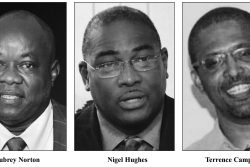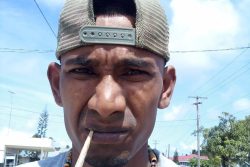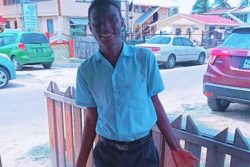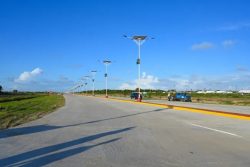Dear Editor,
In February of this year, Guyanese-born author and advocate for stable democracy in Guyana, Dr. Baytoram Ramharack who is a lecturer in history and political science at the Nassau Community College, New York, U. S. A., published his book titled, ‘A Powerful Indian Voice – Alice Bhagwandai Singh: Reflections On Her Work In Guyana’. In explaining the rationale and origin of the book, Dr. Ramharack writes, “Alice was a writer and an iconic social and cultural activist in British Guiana during the early 1900s. Yet I could not recall ever seeing her name, even in passing, in any of the history books I had read as a young high school student at the Berbice Educational Institute”. He continues “My original intention was to include Alice’s story as part of the research on Jung Bahadur (Alice’s husband who was the subject of his previous book)…But such an inclusion would have merely relegated Alice to little more than a historical footnote …In the broader scheme of things, Alice was a liberated woman who challenged the European hegemony in the 1930s by negotiating a cultural space to provide a voice for Indians”. This is a well-researched, scholarly work that is presented like a doctoral dissertation with excellent analyses of the life, time, and accomplishments of Alice Bhagwandai Singh. It consists of 491 pages of which 69 are dedicated to twelve appendices of source documents, and 25 dedicated to a Bibliography of around 270 publications.
According to the author, he sought to explore who is Alice Singh, her role in helping to create an Indian voice in the national cultural space, and the impact of her work on Guyanese society, particularly for Indians. Alice was born in Parimaribo, Suriname (then Dutch Guiana) in 1892 to a Hindu Brahmin father, who was brought to the then colony as a child by his Indian indentured mother, and an Indo-Suriname, Christian mother. At the time, the family lived in a cottage owned by a wealthy Afro-Surinamese with whom they had a close relationship and who became an important part of Alice’s life. She attended convent school and was a good student who was well liked by the nuns. There she was immersed in European culture. At home, she was greatly influenced by her father, a Europeanized Indian in dress and values but a staunch Hindu culturally. At the age of fifteen, she entered the working world as a clerk in her father’s office in the Immigration Department where by then he was the head translator of Indian languages. At eighteen she married Jung Bahadur Singh of Guyana (then British Guiana), a compounder on immigrant ships, the result of an arrangement made by her father and his uncle. Befitting a person of such cosmopolitan background, the marriage was a three-part affair or, in Alice’s words, “I had my civil marriage, so this complied with the law of the land, (and) my church (Christian) blessing for Ma. But the real thing was in the evening my Hindu marriage”.
After the wedding, the couple lived in Guyana for a while then moved to Scotland where her husband attended University and qualified as a medical doctor. Upon return to Guyana, he established a medical practice and became involved in social and cultural activities, serving as a member and then president on a number of occasions of the British Guiana East Indian Association (BGEIA), and founder and President of the British Guiana Sanatan Dharma Maha Sabha (BGSDMS) from around 1935 to 1955. On her part, Alice became an incredible social and cultural activist in her own right. For a while she headed British Guiana Lakshmi Sabha, the female arm of the BGSDMS. Also, she was involved in the Commonwealth Heart and Chest Association, the Girl Guides, the Red Cross, the St. John’s Ambulance Brigade, the Tuberculosis Society, the Women’s League of Social Services, and the YWCA. She was a Board member of the Dharam Sala, an organization that housed and fed the homeless and destitute, and founded the Balak Sahaita Mandalee in 1936, an organization that served poor Indian women and their children. As well, she was appointed by the Governor as a Board member of the Poor Law Commission to review and approve applications for welfare recipients and to the Prison Service Commission where she helped to ensure inmates were treated humanely.
In 1950 she was awarded the Most Excellent Order of the British Empire for her charitable and social work. Apart from the above, and raising seven children as a homemaker, two of her most highly acclaimed accomplishments are (a) her founding, leadership, and guidance of the British Guiana Dramatic Society (BGDS); and (b) her autobiography which is possibly the first such documentation by a female descendant of a girmitiya (labourer who signed the indenture contract). These are analyzed in relation to their significance and contribution to the cultural historiography of the global diaspora of girmitiyas and their descendants. During and in the immediate post indentureship years, European culture was the norm in Guyana, Suriname, and the Caribbean islands. The arriving Indians were not only poor but were seen also as uncultured. Even educated, middle-class Indians were considered “coolies…not really our sort” as noted by prominent Guyanese-born novelist Edgar Mittelholzer in his 1963 autobiography, A Swarthy Boy, regarding their middle-class Indian neighbours in New Amsterdam. In March 1937, following the successful staging in Georgetown of Savitri, a love drama from the epics of India, by Alice with involvement of the rising middle class of young Indians – Hindus, Muslims and Christians, she launched the BGDS at her home in Georgetown. This organization, like the BGEIA, brought together Indians of all religious backgrounds to promote Indian culture and advancement in the society. It functioned until around 1950 and during those years successfully staged many plays by foremost Indian playwrights of international acclaim such as Rabindranath Tagore and others, thereby serving to enhance the perception of Indian culture and gaining respect for Indians.
According to the author, “Alice Singh’s decision to establish the BGDS represents the first time a concerted attempt was made to secure a central voice for Indians in British Guiana”. And writing in the 1944 Christmas edition of Dramag, the magazine of the BGDS, Alice poses a few pertinent questions which are still relevant: “Now we are all trying to be good Guyanese, but even so, would it be right for us to forget our wonderful heritage? Should we just discard and throw away all that is good and wonderful, which a mighty nation has preserved and handed down to us…? In his 1962 book, British Guiana, renowned anthropologist, Professor Raymond Smith, who conducted extensive studies in British Guiana wrote, “The position is, then, that the Indian’s emphasis upon the value and worth-whileness of ‘our Indian culture’ is really a mode of expression of his desire to be treated on terms of equality within a Guianese universe. It is most emphatically not an expression of separatist tendencies.” Her autobiography is an exceptional work which was written in three sittings over a span of twenty years, the last being a year before her passing in 1970. In order to provide context and assess the significance of this work, Dr. Ramharack provides an extensive review of the literature on girmitiya historiography. He writes “The coolitude narrative has advanced from emphasizing the imaginary to utilize available documents to piece together the Indian indenture experience” and notes “The autobiography of Alice Singh represents a valuable narrative that should easily find a comfortable place in the coolitude tradition… It is a primary source document which details the experience of the girmitiyas in Dutch Guiana, one of only two such documents discovered”.
Dr. Ramharack concludes his book with a report on the cultural activism of Mrs. Rajkumari Singh, daughter of Alice, and someone he considers as part of Alice’s legacy. She was an Indian culturist poet and playwright who in 1973 brought together a number of emerging young, Indo-Guyanese writers and performers in what became known as the Messenger Group. Some such as poets Mahadai Das and Janet Naidu, and novelist Rooplall Monar gained fame and recognition for their works. Rajkumari went on to become the Cultural Co-ordinator of the newly created Government program, National Service, a program opposed by the opposition Peoples’ Progressive party and the majority of Indo-Guyanese. A few years later, amidst widespread rumours of rape of young Indian women, including a member of the Messenger Group, Rajkumari resigned her position, explaining that her resignation was due to the sidelining of Indian culture and promoting of the Africanization of Guyanese culture at National Service. In my view, Dr. Ramharack’s analysis of Rajkumari’s role with the National Service could have benefited from opinions of critics of the program. Also, since the matter of her resignation was not pursued by the author who had access to members of the former Messenger Group that participated in National Service, one is left to wonder – Did Rajkumari know of rapes that were rumoured to have occurred and did that influence her decision to quit? However these in no way detract from the importance and usefulness of Dr. Ramharack’s pioneering work which is a valuable addition to girmitiyas historiography.
Sincerely,
Harry Hergash









